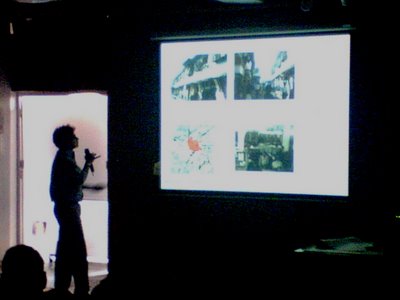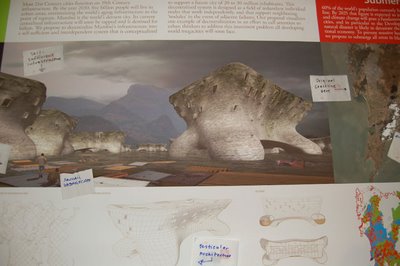
siddharth making the presentation
it seems mumbai is on the international developmental radar as never before. with high real estate prices, lots of possibilities for markets and loans, everyone and their mother seems to have a stake in the city. and nowhere are the stakes more apparent than in the developmental and architectural world. as white skins of all variety seem to walk the streets (or rather hop through the five star hotels) of the city each group seems to have a fabulous solution for the ills of the city- each one more grand than the other.
meanwhile the state seems to be paying a great deal of attention to these proposals and paying none at all to the ground conditions that these grand schemes aim to replace – whole heartedly. enamored by the images of the spanking new the existing is made to have no presence at all in these new cities. this has been plaguing us in the school for a long time now and is becoming more and more apparent in the fights that we have been having over the design cell projects. the schools cess proposal, the big debate over transit oriented development proposals and fsi- all seem to be our ways of beginning to resist these mad inhuman proposals. and then there are those professionals who, eager to lick white ass and completely surrender to these forces, offer no critique at all – and on the other hand fully participate in facilitating them. they are perhaps the most dangerous of all. we hope that we don’t make too many of them.
today in the school we had the big dharavi presentation. this is a design cell project where are working with local community groups to develop a master plan for the redevelopment of dharavi that emerges from an understanding of the local. i don’t know how many you know about the infamous 'mukesh mehta plan' that has been as of now accepted by the state government. the proposal in essence treats dharavi as a blank slate and using an fsi of 4 clears large tracts of land for bandra kurla complex style commercial development. there is absolutely no cognizance of local work and living patterns or historical fabrics. communities are sliced into to create land for fancy glass clad buildings that can be sold at enormous rates. the people of dharavi have rebelled violently against this plan.
the fourth year has been working hard on this project finding real data and doing intense mapping on the site. this was presented to the local community groups and their leaders today. we were very worried of possible animosity and about the chemistry between the groups but it turned out quite well. the students had done a great job of the presentation and it helped convince even the skeptical of our intentions.
now that the project has begun and since we want to base it on a hands on real possibility lets see what kind of plan will emerge.


the meeting
vinita at the base of the huge aerial view of the slum
as an aside i thought i will include some of the other proposals recently made by architecture schools in the us and in
this is sci-arc.. flooding the city and making "testicular architecture" for the rehabilitation. science fiction and disaster movie- is it a wonder that the school is near hollywood.
and this is aa, london. towers over dharavi - the slums below it would seem need no light, no air- no life.
images courtesy – sahil via ninad.







9 comments:
heyy i wonder how u manage to take so many photos during a meeting!!! specially since u create sterility security zones type of situations near the meeting area!!!
btw, those testicular thignies...
its completely ridiculous!
gawd! i cant believe the sci-arc n aa workk ya!....
Man,
I feel bad that SCI_Arc work looks ridiculous here, being an alumni from the school myself. It's completely out of context and obviously lacks any sensitivity to the Dharavi issue.
surprising. i wont talk about practicality, but is there anybody of your fourth year who went inside dharavi talked to people living in there.
i agree that at idea level things can work out,i liked the idea, but the presentation i saw in pic is only imagination. i saw in a meeting pic Mr. Jokin was sitting who has spent his life time in dharavi and won magsesse award by his work in dharavi. did any student ever talked to him before this presentation and after that?
they all did. it was essential to the study.
Hey Rohan,
Good to hear that about the Dharavi project.
Like I was telling Ninad the other day - Mumbai is the talk of the 'world' right now. Mumbai and Dubai paradoxically seem to be the only two cities that anyone in the Western Architecture/Planning circles seems to care about. And at the recently concluded Venice Biennale (were Mumbai was represented by Rahul and gang) these two cities made a lot of noise. And the images that you have seen of Sci-Arc and AA are just the a glimpse of the cruelties that we architects can imagine for great cities like Mumbai. It was sickening beyond belief.
The project by Sci-Arc was the worst atrocities, what you see here is only one scenario while they had four.
However, moving on … while working for Charles I was involved in one of his dreams of developing a housing project for a small site in Dharavi next to the Sparc office. And we worked in close co-ordination with Jockin and I have to say I’m a bit sceptic about his abilities (not his intensions) of being able to present the ‘locals’, though I understand he is your best bet. The school has to be aware of not relying on him alone, he is quiet an elusive character. I really look forward to what you guys come up with.
Hope to hear more about this project and more from Mumbai here soon.
Best Regards,
Sahil
hey you guys, i just bumped into this blog. i must tell you guys these schools have a very different approach to design. as far as i know they do not (in most cases) deal with the current conditions. the idea is to explore new spaces and a new kind of architecture. when it comes to a live projects, i know for sure this wouldn't be their approach.
the idea of having an advanced learning in our field is to bring to the fore an alternate approach against the conventional one, through which we break certain rules. its the experience of spaces during this scenario and to learn something new from it. i have my education from one of these schools and i know what goes on. these are some of the smartest kids in the world and being an indian myself and a love for the field i would vote for these explorations (as long as they do not get built) any day.
...just a quick thought. keep em' coming!
hi rohan. rohan here - rathod. Mom sent me this link so i had a read. I find it aweseome that the design cell has actually taken a step towards the project - when i was working with you guys, Jeet and I went to dharavi (or a similar dwelling, i cannot recall) a couple of times for some visual documentation and i must say the place was quite amazing. Neither do I think nor observe nor feel the way you architects do about spaces but i just felt the place was perfect as it was - apart from the sanitation which its inhabitants are by now immune to, the place was quite cozy. It had ventilation, it was softly lit. It was a labyrinth, which gave it character, making it fun to walk through, like a little adventure. But again, thats how an outsider looks at it.
So please, enlighten me because I cannot understand - why is it such an issue? Do the people really want to resurrect their neighborhood - because they seemed content. They have their TVs, their fans, their food, water. Hell, they even have air conditioners. So what is the reason for undertaking the project?
hey rohan.. actually that’s a very good question.. is in- why redevelop? the thing is that there could be many solutions possible to the way in which the area can be improved- after all there are some serious light and ventilation and health related issues. also there are fundamental infrastructural issues as far as the community is concerned- open spaces, schools, etc. but the entire of the slum does not need to be razed to provide these. there have been solutions historically when looking at slums that have been developed that look at small interventions and also those that provide opportunities for incremental growth. however, these all became defunct with the introduction of the sra model for redevelopment. undea this model private developers were involved in rehousing slum dwellers and in return got additional floor space that they could sell in the open market. as a result slums stopped being housing but instead became potential profit earners for builders. slum dwellers were also pleased- not only because they then were ‘officialized’ within the apartment but also because the desire manufactured by our society sees the ‘flat’ as a step up in the ladder from the ‘hut’. with this the type of housing being imagined also was automatically predetermined because the slum had to be cleared from occupying ground so that more area could be freed up for the sale component. apartment buildings became the norm for the rehoused slum. these buildings are difficult to maintain for the slum dwellers as they have elevators that are expensive and also the minimum square foot provided does not allow for the slum dweller to continue the kind of work that they used to – like the making of foodstuff, selling grocery, etc. community fabric was also disrupted. as a result many of the rehoused get pushed back to another slum. the dharavi plan was proposed by the state as it saw the real estate prices right across the river from dharavi in bandra kurla complex and realized that the slum could be imagined as an extension of the commercial area. although the residents see the plan as an opportunity to ‘better’ their surroundings they are aghast at the plan itself. they approached us to prepare an ‘alternate’ plan. the basic model of the sra though could not be challenged as its viability- especially since the state has no monetary responsibility and this model seems ot have become the norm as far as redevelopment in this city is concerned- unfortunately could not be challenged. what is sadder is that this same model is being promoted across different cities in india.
Post a Comment